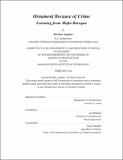| dc.contributor.advisor | Ana Miljački. | en_US |
| dc.contributor.author | Angelov, Borislav(Borislav L.) | en_US |
| dc.contributor.other | Massachusetts Institute of Technology. Department of Architecture. | en_US |
| dc.date.accessioned | 2019-07-18T20:31:39Z | |
| dc.date.available | 2019-07-18T20:31:39Z | |
| dc.date.copyright | 2019 | en_US |
| dc.date.issued | 2019 | en_US |
| dc.identifier.uri | https://dspace.mit.edu/handle/1721.1/121811 | en_US |
| dc.description | This electronic version was submitted by the student author. The certified thesis is available in the Institute Archives and Special Collections. | en_US |
| dc.description | Thesis: M. Arch., Massachusetts Institute of Technology, Department of Architecture, 2019 | en_US |
| dc.description | Cataloged from PDF version of thesis. | en_US |
| dc.description | Includes bibliographical references (pages 99-101). | en_US |
| dc.description.abstract | The thesis looks at the very specific economic and political circumstances in post-Communist Bulgaria that led to the emergence of Mafia Baroque as a distinct architectural style and an instrument for communicating power. Building on the context of the economic meltdown of the mid-1990s, the urban development out-pacing the changing regulatory environment due to corruption, , and the unclear laws relating to land restitution and private development- it seeks to understand how these mafia individuals exploited the construction industry and architecture, and what the future manifestations of these mechanisms could be. A new wave of rural migration to the cities and the current construction boom, present an opportunity for these macho nationalist "businessmen" to establish themselves as "righteous members and builders of society". The thesis will neither seek to create a dialectical- "cleaned up" version of Mafia Baroque nor will it just serve as a cautionary tale projecting a bleak future. If ornament used to be a direct product of crime, could it now express its patron's ulterior motive for an improved urban environment as it takes on additional collective functions besides communicating power? The previous flat kit bashing of parts will be replaced with new programmatic and spatial explorations that seek to project a new synthetic urban condition replacing the individualized enclaves of the present. | en_US |
| dc.description.statementofresponsibility | by Borislav Angelov. | en_US |
| dc.format.extent | 101 pages | en_US |
| dc.language.iso | eng | en_US |
| dc.publisher | Massachusetts Institute of Technology | en_US |
| dc.rights | MIT theses are protected by copyright. They may be viewed, downloaded, or printed from this source but further reproduction or distribution in any format is prohibited without written permission. | en_US |
| dc.rights.uri | http://dspace.mit.edu/handle/1721.1/7582 | en_US |
| dc.subject | Architecture. | en_US |
| dc.title | Ornament because of crime : learning from Mafia Baroque | en_US |
| dc.type | Thesis | en_US |
| dc.description.degree | M. Arch. | en_US |
| dc.contributor.department | Massachusetts Institute of Technology. Department of Architecture | en_US |
| dc.identifier.oclc | 1103712322 | en_US |
| dc.description.collection | M.Arch. Massachusetts Institute of Technology, Department of Architecture | en_US |
| dspace.imported | 2019-10-04T21:35:58Z | en_US |
